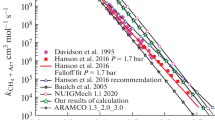Abstract
Homogeneous gas‐phase pyrolysis of methane in a shock tube is numerically studied. The process of pyrolysis occurs under the action of a shock wave reflected from the end face of the tube. An inviscid one‐dimensional flow and a viscous two‐dimensional flow are considered. Two‐dimensional computations are performed on the basis of unsteady Navier–Stokes equations. The kinetic models used are Kassel's simplified gross scheme with 4 reactions and 5 chemical components of methane transformation and a more detailed kinetic scheme with 21 reactions and 13 chemical components. The computations are performed for the Mach number of the incident shock wave equal to M = 5.5. It is shown that the temperature behind the reflected shock wave rapidly decreases because the pyrolysis reaction is endothermic. For this reason, the chemical transformations in the course of pyrolysis are terminated when the total mass concentration of ethylene and acetylene is within 15 %. Additional heating of the gas is needed for deeper conversion of methane to ethylene and acetylene.
Similar content being viewed by others
REFERENCES
R. A. Buyanov, N. A. Vasil'eva, V. N. Parmon, et al., “Endothermal chemical reactor with gas-dynamic con-trol,” Preprint No. 5-2001, Inst. Theor. Appl. Mech., Sib. Div., Russian Acad. of Sci., Novosibirsk (2001).
L. S. Kassel, J. Amer. Chem. Soc., 54, 3949 (1932).
Y. Hadaka et al., “High temperature pyrolysis of methane in shock waves,” Int. J. Chem. Kin., 22, 701– 709 (1990).
K. Tabayashi and S. H. Bauer, “The early stages of py-rolysis and oxidation of methane,” Combust. Flame, 34, 63–83 (1979).
Y. Hadaka et al., “Shock-tube and modeling of methane pyrolysis and oxidation,” Combust. Flame, 118, 340– 358 (1999).
V. P. Glushko et al. (eds.), Thermodynamic Properties of Individual Substances [in Russian], Nauka, Moscow (1979).
D. C. Wilcox, “Turbulence modelling for CFD,” DCW Industries Inc., La Canada, California (1993).
V. M. Kovenya and N. N. Yanenko, Splitting Method in Gas-Dynamic Problems [in Russian], Nauka, Novosi-birsk (1981).
B. Van Leer, “Flux-vector splitting for the Euler equa-tions,” Technical Report No. pp82–30, ICASE (1982).
I. A. Bedarev and N. N. Fedorova, “Investigation of fac-tors affecting the quality of prediction of turbulent sep-arated ows,” Vychisl. Tekhnol., 4, No. 1, 14–33 (1999).
Author information
Authors and Affiliations
Rights and permissions
About this article
Cite this article
Bedarev, I.A., Parmon, V.N., Fedorov, A.V. et al. Numerical Study of Methane Pyrolysis in Shock Waves. Combustion, Explosion, and Shock Waves 40, 580–590 (2004). https://doi.org/10.1023/B:CESW.0000041411.91918.9b
Issue Date:
DOI: https://doi.org/10.1023/B:CESW.0000041411.91918.9b




